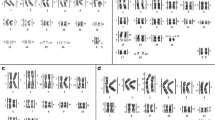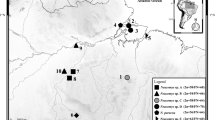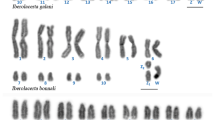Abstract
We used human-specific probes for chromosomes 3, 11, 14, 15, 17, 19, 21 to paint chromosomes of four species of Indridae (Avahi laniger, Indri indri, Propithecus verreauxi, and P. diadema). All human chromosome probes hybridized specifically to chromosome segments or to whole arms of indrid chromosomes. In general, the results obtained by chromosome painting confirm those obtained by R-banding except for some reciprocal translocations undetected by R-banding. Our findings confirm that in the evolution of the Indridae, Avahi laniger first emerges, then Indri and Propithecus share a common trunk. After populational evolution, this sister clade diverged.
Similar content being viewed by others
REFERENCES
Apiou, F., Rumpler, Y., Warter, S., Vezuli, A., and Dutrillaux, B. (1996). Demonstration of homoeologies between human and lemur chromosomes by chromosome painting. Cytogenet. Cell Genet. 72: 50–52.
DelPero, M. (1995). Filogenesi Moleculare degli Strepsirhini: Studio del DNA Mitocondriale. Tesi di Dottorato VII Ciclo. Università degli Studi di Firenze, di Torino, di Pisa, Italy.
Dutrillaux, B. (1979). Chromosomal evolution in primates: Tentative phylogeny from Microcebus murinus (Prosimian) to man. Hum. Genet. 48: 251–314.
Hill, W. C. O. (1953). Primates: Comparative Anatomy and Taxonomy. Vol I. The University Press, Edinburgh.
Jung, K. Y., Warter, S., and Rumpler, Y. (1990). Diagrammatic representation of R-and Gbanded Karyotypes of Mayotte brown lemur (Eulemur fulvus mayottensis). Hum. Evol. 5(6): 537–541.
Petter, J. J., Albignac, R., and Rumpler, Y. (1977). Mammifè res Lémuriens (Primates Prosimiens). Faune de Madagascar, Vol. 44, C.N.R.S./O.R.S.T.O.M., Paris.
Razafindraibe, H., Montagnon, D., and Rumpler, Y. (1997). Phylogenetic relationships among Indridae (Primates, Strepsirhini) inferred from highly repeated DNA band patterns. C.R. Acad. Sci. Paris, Sciences de la Vie 320: 469–475.
Rumpler, Y., and Dutrillaux, B. (1990). Chromosomal Evolution and Speciation in Primates. R.B.C., University of the Basque Country (ed.), Vol. 23, Springer-Verlag, Berlin/ Heidelberg/New York.
Schertan, H., Cremer, T., Arnason, U., Weier, H. U., Lima de Faria, A., and Frönicke, L. (1994). Comparative chromosome painting discloses homologous segments in distantly related mammals. Nature Genet. 6: 342–347.
Tattersall, I. (1982). The Primates of Madagascar. Columbia University Press, New York.
Tattersall, I., and Sussman, R. (1975). Lemur Biology. Plenum Press, New York and London.
Vezuli, A., Hauwy, M., Warter, S., and Rumpler, Y. (1997). Chromosome painting: An available method to test the chromosomal changes during evolution of lemurs. Cytogenet. Cell Genet. 78: 147–152.
Author information
Authors and Affiliations
Rights and permissions
About this article
Cite this article
Warter, S., Hauwy, M. & Rumpler, Y. Chromosome Painting Technique Contributes to Constructions of Evolutionary Trees of Lemurs. International Journal of Primatology 21, 905–913 (2000). https://doi.org/10.1023/A:1005554911728
Issue Date:
DOI: https://doi.org/10.1023/A:1005554911728




